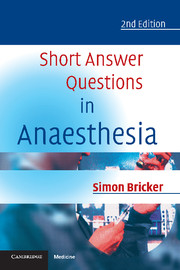Book contents
- Frontmatter
- Contents
- Preface
- Preface to the 1st edition
- Abbreviations
- 1 Advice on answering short answer questions
- 2 General Anaesthesia
- 3 Anaesthesia and Medical Disease
- 4 Medicine and Intensive Care
- 5 Obstetric Anaesthesia and Analgesia
- 6 Paediatric Anaesthesia
- 7 Neuroanaesthesia
- 8 Acute and Chronic Pain
- 9 Trauma and Emergency Anaesthesia
- 10 Anatomy, Applied Anatomy and Regional Anaesthesia
- 11 Pharmacology and Applied Pharmacology
- 12 Clinical Measurement and Equipment
- 13 Cardiac and Thoracic Anaesthesia
- Index
12 - Clinical Measurement and Equipment
Published online by Cambridge University Press: 05 February 2014
- Frontmatter
- Contents
- Preface
- Preface to the 1st edition
- Abbreviations
- 1 Advice on answering short answer questions
- 2 General Anaesthesia
- 3 Anaesthesia and Medical Disease
- 4 Medicine and Intensive Care
- 5 Obstetric Anaesthesia and Analgesia
- 6 Paediatric Anaesthesia
- 7 Neuroanaesthesia
- 8 Acute and Chronic Pain
- 9 Trauma and Emergency Anaesthesia
- 10 Anatomy, Applied Anatomy and Regional Anaesthesia
- 11 Pharmacology and Applied Pharmacology
- 12 Clinical Measurement and Equipment
- 13 Cardiac and Thoracic Anaesthesia
- Index
Summary
Describe the physical principles of the pulse oximeter. What are the limitations of the technique?
Most anaesthetists believe that continuous measurement of oxygen saturation during anaesthesia is absolutely essential. Equally essential, therefore, is a broad understanding of how the technique works with particular reference to its limitations and potential sources of error.
Introduction
Pulse oximetry has been widely available for only about 12 years but very rapidly has become established as arguably the single most important form of monitoring in anaesthetic practice.
Physical principles
Oxygenated haemoglobin (HbO2) and deoxygenated haemoglobin (Hb) have differential absorption spectra.
At a wavelength of 660 nm (red light) HbO2 absorbs less than Hb, hence its red colour.
At a wavelength of 940 nm (infra-red light) this is reversed and Hb absorbs more than HbO2. At 800 nm – the isobestic point - the absorption coefficients are identical.
The pulse oximeter uses two light emitting diodes which emit pulses of red (660 nm) and infra-red (980 nm) light every 5–10 μs from one side of the probe. The light is transmitted through tissue to be sensed by a photocell.
The output is submitted to electronic processing during which the absorption of the blood at the two different wavelengths is converted to a ratio which is compared to an algorithm produced from experimental data.
[…]
- Type
- Chapter
- Information
- Short Answer Questions in Anaesthesia , pp. 297 - 312Publisher: Cambridge University PressPrint publication year: 2002



